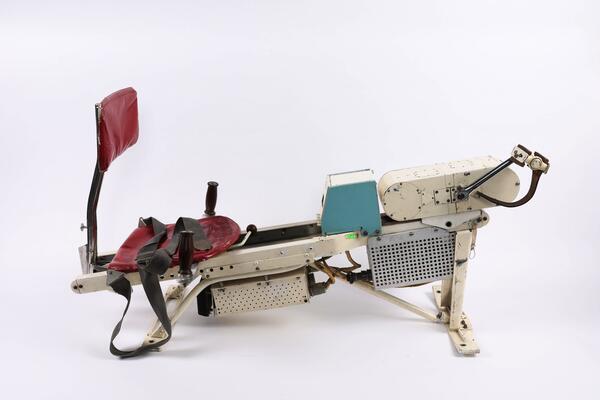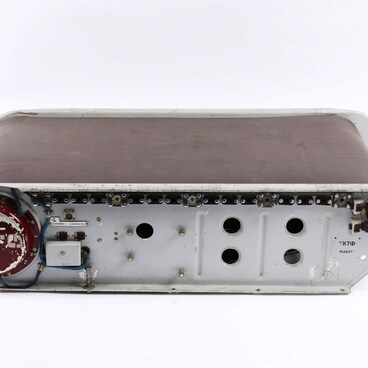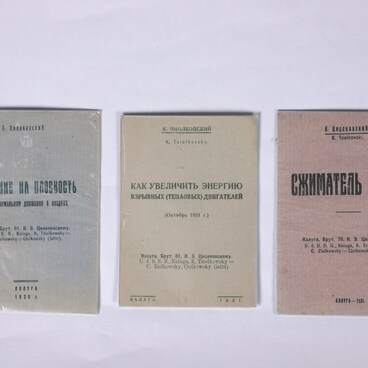This training machine is a kind of bicycle without wheels, that allows the user to exercise while undergoing medical and biological experiments and tests. It is one of the most important exercise machines on any space station where cosmonauts stay on long-term missions.
Lengthy periods in zero gravity conditions can have a very negative effect on cosmonauts’ bodies, causing their muscles to waste and the locomotor system to stop functioning properly. In order to stay healthy cosmonauts need to engage in various preventative activities. One resistance-based approach is to wear a special Pingvin (‘Penguin’) exercise suit. And an active method is to train on exercise equipment.
Salyut-1, the first space station, was equipped with various devices to help cosmonauts stay fit, including a treadmill. A new machine, the ergometer bicycle, appeared on later space stations. The cosmonaut rested his back against the back-rest, which provided support. He could push the pedals with either his hands or his feet. The device had a rheostat, which allowed the user to increase resistance and regulate the intensity of the training.
This machine could be used to exercise various different groups of muscles. Since in conditions of weightlessness the cosmonaut’s legs do much less work than on Earth, it is particularly important to exercise the leg muscles. But the arm muscles should not be neglected either. In the Salyut-4 space station (1974–1977) the exercise bicycle was installed on the “ceiling” of the living section. In the main section of the Mir space station (1986–2001) it was on the “floor”, next to the treadmill.
At the moment there are two ergometer bicycles on board the International Space Station, one Russian and one American. The Russian one is in the Zvezda service module. Its compact folding design means that it can be kept under the “floor” area when not needed, and brought out when the cosmonauts are ready to start training. The cosmonauts spend more than two hours a day on physical training — an hour on the ergometer bicycle and an hour on the treadmill. This creates resistance for the locomotor system and exercises the circulatory system. As a result the cosmonaut is better able to deal with the additional load they experience on returning to Earth and adapt to its gravity more quickly. Physical activity also has psychological benefits — it helps the astronauts relax and improves their mood.
Lengthy periods in zero gravity conditions can have a very negative effect on cosmonauts’ bodies, causing their muscles to waste and the locomotor system to stop functioning properly. In order to stay healthy cosmonauts need to engage in various preventative activities. One resistance-based approach is to wear a special Pingvin (‘Penguin’) exercise suit. And an active method is to train on exercise equipment.
Salyut-1, the first space station, was equipped with various devices to help cosmonauts stay fit, including a treadmill. A new machine, the ergometer bicycle, appeared on later space stations. The cosmonaut rested his back against the back-rest, which provided support. He could push the pedals with either his hands or his feet. The device had a rheostat, which allowed the user to increase resistance and regulate the intensity of the training.
This machine could be used to exercise various different groups of muscles. Since in conditions of weightlessness the cosmonaut’s legs do much less work than on Earth, it is particularly important to exercise the leg muscles. But the arm muscles should not be neglected either. In the Salyut-4 space station (1974–1977) the exercise bicycle was installed on the “ceiling” of the living section. In the main section of the Mir space station (1986–2001) it was on the “floor”, next to the treadmill.
At the moment there are two ergometer bicycles on board the International Space Station, one Russian and one American. The Russian one is in the Zvezda service module. Its compact folding design means that it can be kept under the “floor” area when not needed, and brought out when the cosmonauts are ready to start training. The cosmonauts spend more than two hours a day on physical training — an hour on the ergometer bicycle and an hour on the treadmill. This creates resistance for the locomotor system and exercises the circulatory system. As a result the cosmonaut is better able to deal with the additional load they experience on returning to Earth and adapt to its gravity more quickly. Physical activity also has psychological benefits — it helps the astronauts relax and improves their mood.



